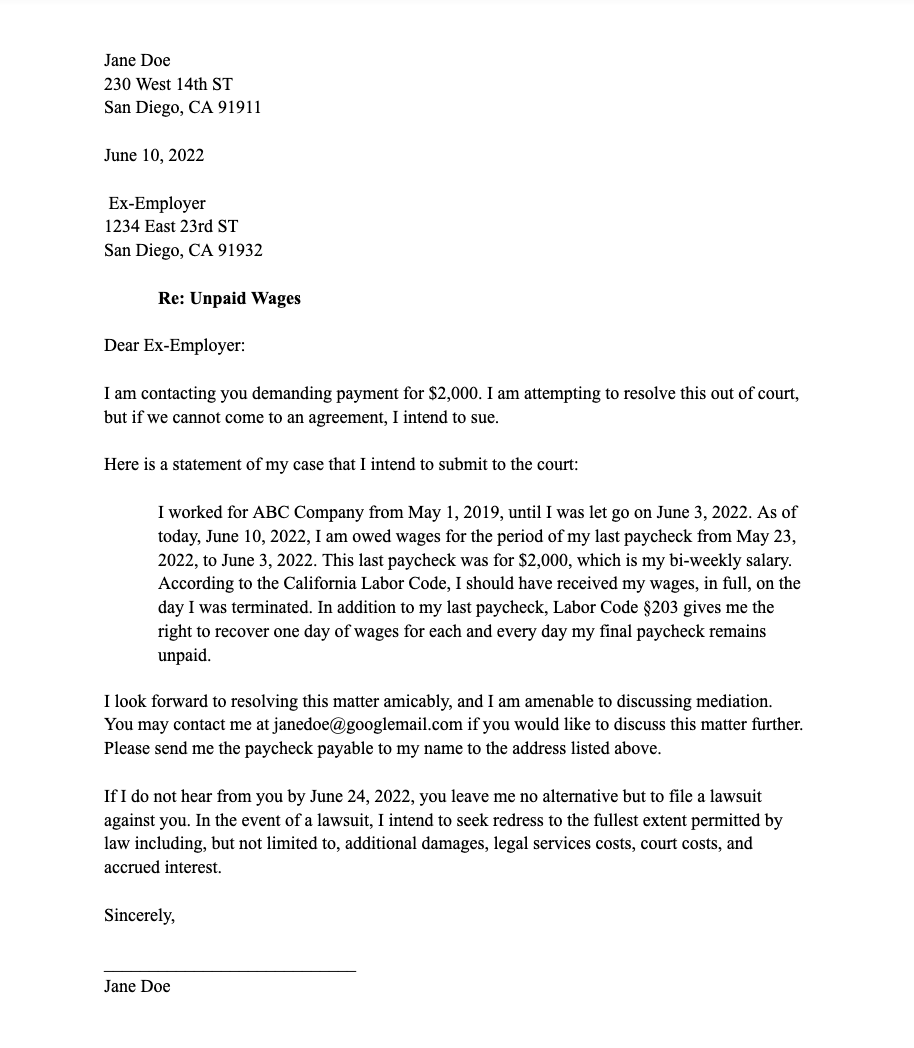Contents
Has your employer failed or refused to pay you the wages you are owed? This can happen if an employer has not given an employee a last paycheck, wages for unused earned vacation pay, or simply regular monthly wages.
These issues, sometimes referred to as “wage theft,” can be quite stressful. Luckily, you have options. For one, you can send your employer a demand letter for unpaid wages.
In this article, learn how to write a demand letter to your employer for unpaid wages, see a sample demand letter, and what to do after sending a demand letter.
Looking to send a demand letter? Request an attorney demand letter or use our free demand letter template to write one.
Get Started ➜Why is a Demand Letter for Unpaid Wages Important?
An effective and straightforward way to demand your wages is to send your employer a well-crafted demand letter. The main point of the letter is to state you are owed wages and that you want to collect. Here are at least four reasons to first send a demand letter to your employer:
Depending on the state you are filing a lawsuit in, you may be required to demand payment from the other party before filing. For example, in California small claims court demanding payment is a requirement.
A demand letter can help you better organize your case. If you end up filing a lawsuit, you will need to make a concise claim and prove your case to a judge. Writing a demand letter will help you think through every aspect of your case, including the important facts, your legal arguments, and the evidence you'll need to prove your claim. With a demand letter, you will be prepared for litigation even before you file a lawsuit.
You can use your demand letter as evidence in court. Not only can you use a demand letter to show the judge you tried to resolve the dispute outside of court, but you can also use your demand letter to show your employer may be liable for “waiting time penalties.” This means your employer avoided paying your last paycheck even after you asked for the money.
The most important reason to send a demand letter is that it may lead to you receiving your wages without legal action.
What Are Waiting Time Penalties? 
Some states have laws that specify when an employer needs to pay an employee their final wages after resigning or being terminated. Further, if an employer doesn’t pay their employee within the specified time, the law imposes “waiting time penalties.”
This means that in addition to the unpaid wages the employer owes, the employer will also have to pay you additional penalties. For example, in California, under Labor Code sec. 203, employers are liable for waiting time penalties equal to the employee’s daily rate of pay for each day the wages are late (for up to 30 days).
Note: Waiting time penalties apply to employees who have not been paid their salary. If you are a contractor and are waiting on payments from clients, go to our article here to learn how to send a demand letter for outstanding invoices.
Do I Need to Hire an Attorney to Write a Demand Letter for Unpaid Wages? 
We often get the question, "Do you need an attorney to write a demand letter?" Ultimately, the decision is up to you. There is no formal requirement that you need a lawyer to write your demand letter; you can do it yourself.
However, there are many attorneys out there who specialize in claims relating to unpaid wages. These attorneys are referred to as employment law attorneys or wage-and-hour attorneys.
Learn about the pros and cons of using an attorney to write a demand letter.
What to Include in Your Demand Letter 
Below are suggestions on important elements to include in your letter for unpaid wages:
Background facts describing the wages that are owed. This is probably the most important part of the letter. Make sure to include facts and details about the wages you are owed. For example, does your employer owe you your last paycheck or wages from benefits like unused vacation time?
Use concise and polite language when discussing facts or making your demand. Remember, you are trying to resolve the issue without escalating the matter any further. Throughout the letter, stick to the facts surrounding your situation and refrain from making illegal threats or using derogatory language.
State how your employer can pay the wages. For example, if you have already left the company, consider including a mailing address where your ex-employer can send a check for the unpaid wages.
Include a deadline and intent to sue language. You may want to consider giving your employer 14 days to respond to you and state that if they do not respond within that time, you intend to sue them.
Add your signature. At the end of the letter, sign your name.
Attach any documents or other pertinent evidence.
Once you have sent your demand letter, keep it in your records. In the event you do end up filing a small claims lawsuit, you can bring it to the hearing and show it to the judge. This is especially handy if your employer claims they didn’t receive the complaint letter.
Sample Demand Letter for Unpaid Wages
Below is a sample demand letter. This sample letter discusses unpaid wages for an ex-employee. When using this sample, make sure to incorporate your own facts and laws from your state.

With our letter service, we ship your letter for you using Certified or Priority Mail.
Get Started ➜How to Send a Demand Letter for Unpaid Wages
In general, you may send your demand letter via email or mail. However, you can also hand deliver the letter if you wish. For letters that you mail, consider sending your letter with tracking information so that you know when it has been delivered.
What to Do After Sending a Demand Letter for Unpaid Wages 
If you sent a demand letter and have not received a response or your unpaid wages, it may be time to take legal action.
Two options for collecting unpaid wages after sending a demand letter are:
Contact your State Labor Office.
Continue Reading: No Response to a Demand Letter? Next Steps.
Consider Contacting Your State Labor Office
Contact your State Labor Office to discuss any questions you may have about your unpaid wages. Your state labor office may advise you on specific state wage laws your employer may have violated when they didn’t pay you.
You can also file a claim or complaint with your state’s labor office. For example, the California Department of Industrial Relations & the Labor Commissioner's Office allows employees who have experienced some type of wage theft to file a claim online.
Note, you may also be able to file a complaint directly with the U.S. Department of Labor (“DOL”), but typically, you need to use state resources before moving to the federal level. Further, not all employers are required to follow the federal Fair Labor Standards Act, which means the DOL may not be able to help you.
Consider Suing in Small Claims Court
You can also sue in small claims court for unpaid wages. Small claims courts handle a variety of different small claims cases, including cases against employers for unpaid wages. Small claims courts were also designed as an affordable and user-friendly way for everyday people to seek justice on their own without the need for an attorney.
To win your small claims case, you need to be prepared for the small claims hearing. Here are some ways you can prepare for your small claims court hearing:
Research the law. For example, if you are seeking “waiting time penalties” on top of your unpaid wages, make sure you have the right legal codes ready to show the judge. Small claims judges see all types of cases, and they may not be well-versed in wage and labor laws.
Prepare your evidence. As discussed above, the judge at your hearing may not know much about the law surrounding your claim and definitely isn’t going to know the facts of your case. Prepare and organize your evidence, as it is your responsibility to prove your side at the hearing. JusticeDirect can help you organize a judge-friendly evidence packet for your small claims hearing.
Prepare what you will say at the hearing. At small claims hearings, the judge asks both parties to present their side of the story. Typically, the person who brought the lawsuit goes first. This is where you have the chance to let the judge know why you are suing your employer or ex-employer, how much unpaid wages they owe you, and how you calculated that amount.
Bring multiple copies of your evidence. You should bring at least three copies of your evidence. One copy for you, one copy for the judge, and one copy for your employer or ex-employer.
Up next: 5 Mistakes to Avoid During a Small Claims Hearing.
We can help you with a demand letter. Request an attorney demand letter or write a demand letter using our free tool.
Create Demand Letter ➜
Camila Lopez, Esq.
Attorney at JusticeDirect. Camila holds a law degree and is a certified mediator. Her passion is breaking down complicated legal processes so that people without an attorney can get justice.

